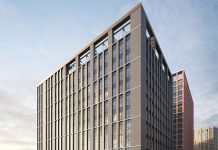Nearly one million sq. ft. of office space was created in Manchester last year, a whopping 75 per cent increase on the year before and the appetite for more space is expected to continue in 2018. This growth is set to change our skyline and with it, change the way that light is shared in our urban centres. Our little known Rights of Light laws are centuries old and the methods of measurement remain largely unchanged, nonetheless this legal liability for developers is as significant as ever and can prove very costly if overlooked.
Ben Salvage, Head of Rights of Light & Daylight Sunlight at Colliers International commented: “Right to Light is an English legal agreement, based on the Ancient Lights Law, that provides a long-standing owner of a building with windows, skylights and glass roofs a right to maintain a sufficient level of illumination. The rights are most usually acquired under the Prescription Act 1832 and is something that developers must be aware of from the off and address it head on or otherwise, you may see yourself breaching the law and costly action being taken against you for obstructing light in a neighbouring development.”
Ben provides his top tips for developers below:
- Start early: If you approach this early enough and the main Rights of Light constraints have been identified, a good surveyor will be able to create a 3D maximum envelope which will show the volume that can be built without impacting this legality and will be able to design steer your scheme in the right direction to ensure the appropriate strategy is put in place.
- Aerial photography is not enough, get a survey done: It goes without saying, this legal issue needs accurate assessment. Where possible, we recommend basing your 3D modelling on a digital laser scans, not aerial photogrammetry. The latter bases its measurement from above so ledges, balcony’s, cornices and columns dictate the shape and size of the building. There have been previous legal cases where unnecessary amounts of compensation were paid out due to poor 3d modelling so ensure you do your homework and are receiving adequate counsel.
- What are the Rights of Light positions surrounding your development? Generally speaking, windows, skylights and glass roofs in buildings where unobstructed light has not been an issue for at least 19 years and 1 day will have established a Right to Light, under Section 3 of the Prescription act 1832, (if they do something for long enough they earn the right to continue doing it). However, there are different methods of establishing rights and these privileges can also be removed. You should always seek legal professional advice on this, so you know the extent of your liability.
- Be open to negotiations even with insurance: Solutions to Rights of Light infringements might include cutting back or redesigning your scheme to reduce infringement to neighbours. However, if this cannot be avoided, you should be open to negotiate with them. There are insurance products these days that can allow you to start negotiations whilst still having a financial safety net in case they fall apart or become litigious. With proper strategy and advice from a specialist, you can mitigate cost and choose the best package for you.
- Be considerate: If a Rights of Light agreement cannot be reached, be aware that the legal environment surrounding Rights of Light today is very much geared around the behaviour of the parties, particularly the developer. If you ever find yourself in court, this would be a major consideration in determining the outcome as you might find continued construction for your development being prevented, delayed or reduced in size, even if part of the scheme which is being cut back has already been let off-plan.





















